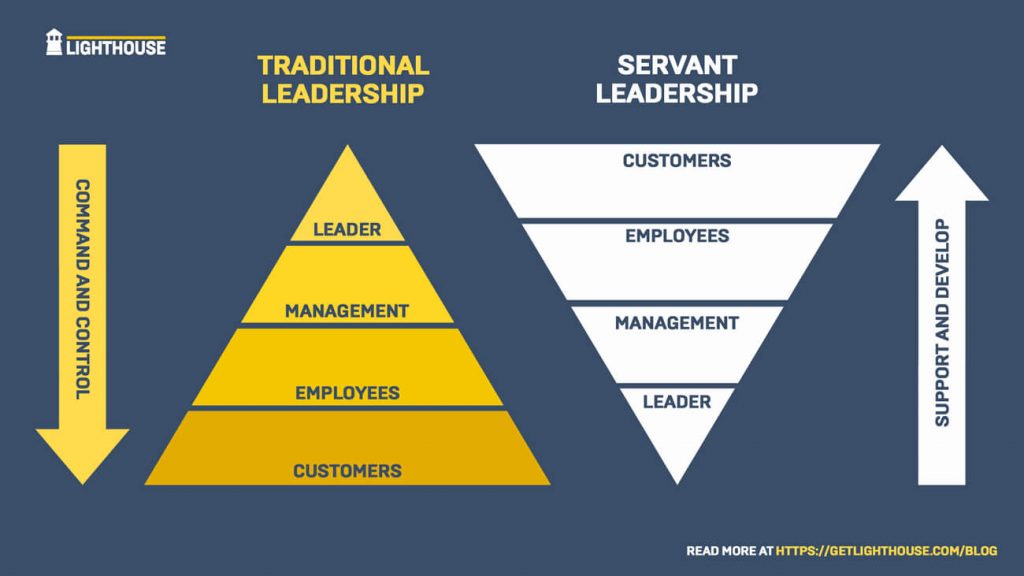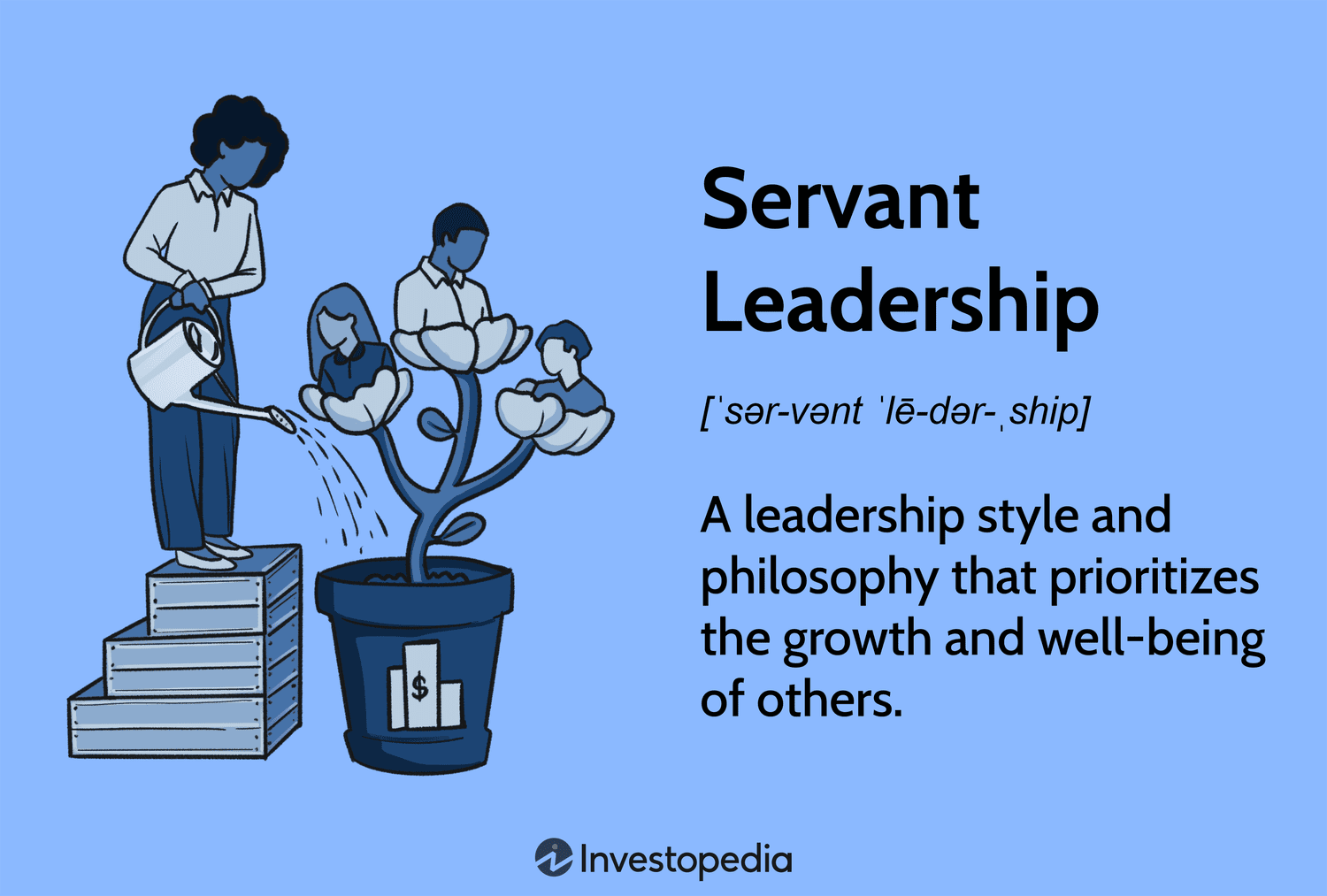The Power of Servant Leadership: Transforming Organizations and Teams
In today’s fast-paced and ever-changing business environment, effective leadership is more crucial than ever. Among various leadership styles, servant leadership stands out as a transformative approach that emphasizes the needs of employees and stakeholders. This article will explore the core concepts, benefits, and practices of servant leadership, providing insights into how it can drive organizational success.
:max_bytes(150000):strip_icc()/servant-leadership.asp-final-384659cdeae8488fb6867c08395d4017.png)
Understanding Servant Leadership
What is Servant Leadership?
Servant leadership is a leadership philosophy that focuses on serving others, prioritizing their needs, and fostering a collaborative environment. Unlike traditional leadership styles, which often emphasize hierarchy and control, servant leadership encourages leaders to act as supporters and facilitators of their teams. The primary goal is to enhance the personal and professional growth of team members while also improving organizational effectiveness.
Historical Background
The concept of servant leadership was popularized by Robert K. Greenleaf in his 1970 essay, “The Servant as Leader.” Greenleaf argued that the most effective leaders are those who serve others, putting the needs of their employees first. His ideas have since inspired a growing body of literature and research focused on the importance of empathy and support in leadership.
Key Principles of Servant Leadership
Servant leadership is grounded in several key principles:
- Listening: Leaders actively listen to the concerns and feedback of their team members.
- Empathy: Understanding and addressing the emotions and experiences of others is vital.
- Stewardship: Leaders take responsibility for their actions and the well-being of their team.
- Community Building: Creating a sense of belonging and collaboration among team members fosters a positive workplace culture.
These principles guide servant leaders in their decision-making and interactions, promoting a more engaged and motivated workforce.
Benefits of Servant Leadership
Implementing servant leadership can lead to significant benefits for both employees and organizations. Here are some of the key advantages:
Enhanced Employee Engagement
Organizations that practice servant leadership often see higher levels of employee engagement. When leaders prioritize the needs and well-being of their team, employees feel valued and motivated to contribute. This can lead to:
- Increased job satisfaction
- Higher retention rates
- Greater commitment to organizational goals
Improved Team Collaboration
Servant leadership encourages collaboration and teamwork by creating an environment where team members feel safe to share ideas and perspectives. This collaborative spirit can result in:
- Enhanced creativity and innovation
- Better problem-solving capabilities
- Stronger interpersonal relationships
Increased Organizational Performance
Research has shown that organizations with servant leadership practices tend to perform better overall. The focus on employee well-being and collaboration can lead to:
- Improved productivity
- Higher quality of work
- Positive organizational culture
By investing in the growth and development of employees, servant leaders contribute to the long-term success of their organizations.

Characteristics of a Servant Leader
To embody servant leadership, certain characteristics are essential:
Empathy
Empathetic leaders understand their team members’ feelings and perspectives. This understanding enables them to respond to individual needs effectively.
Listening
Servant leaders practice active listening, ensuring that team members feel heard and valued. This practice encourages open communication and builds trust.
Stewardship
A servant leader views themselves as a steward of their organization and its people, taking responsibility for their actions and decisions.
Community Building
By fostering a sense of community, servant leaders create an environment where collaboration and support thrive, contributing to a positive organizational culture.
Implementing Servant Leadership in Your Organization
Assessing Your Leadership Style
Before adopting servant leadership practices, it’s essential to evaluate your current leadership style. Consider conducting a self-assessment or seeking feedback from peers and team members to identify areas for improvement.
Training and Development
Implementing servant leadership may require training and development for both leaders and team members. Workshops, seminars, and coaching can help cultivate the necessary skills and mindset.
Fostering a Servant Leadership Culture
To create a culture of servant leadership, organizations should encourage open communication, recognition of employee contributions, and a commitment to professional growth. Leadership should model these behaviors to inspire others.
Real-Life Examples of Servant Leadership
Case Study 1: Starbucks
Starbucks is renowned for its commitment to servant leadership. The company prioritizes employee well-being, offering benefits such as healthcare, education support, and opportunities for career advancement. This approach not only boosts employee morale but also enhances customer satisfaction.
Case Study 2: The Container Store
The Container Store is another prime example of servant leadership in action. The company emphasizes employee engagement and training, ensuring that staff feel valued and empowered to serve customers effectively. This focus on service leads to strong sales and customer loyalty.
“The best way to find yourself is to lose yourself in the service of others.” – Mahatma Gandhi
In conclusion, the principles and practices of servant leadership not only benefit employees but also contribute to the long-term success of organizations. By embracing this leadership style, leaders can create a more engaged, collaborative, and high-performing workforce.
FAQs
- What is the primary focus of servant leadership?
- The primary focus of servant leadership is to serve the needs of team members and stakeholders, promoting their personal and professional growth.
- How does servant leadership differ from traditional leadership?
- Unlike traditional leadership, which often emphasizes authority and control, servant leadership prioritizes empathy, listening, and collaboration.
- Can servant leadership improve employee retention?
- Yes, organizations that practice servant leadership often experience higher employee retention rates due to increased job satisfaction and engagement.
- What are some common misconceptions about servant leadership?
- Common misconceptions include the belief that servant leadership is a sign of weakness or that it lacks decisiveness. In reality, effective servant leaders are both compassionate and decisive.
For more information on leadership styles, check out our article on leadership styles. For a deeper dive into employee engagement strategies, visit employee engagement.
The Future of Leadership: Embracing Servant Leadership
As we delve deeper into the transformative effects of servant leadership, it’s essential to recognize its impact on the future of organizational dynamics. In an era marked by rapid technological advancements and shifting employee expectations, organizations that adopt a servant leadership approach are better positioned to thrive.

Challenges to Implementing Servant Leadership
While the benefits of servant leadership are numerous, implementing this approach is not without challenges. Here are some common hurdles organizations may face:
- Cultural Resistance: In organizations with deeply ingrained hierarchical structures, transitioning to a servant leadership model can meet resistance from those accustomed to traditional leadership methods.
-
Training Needs: Servant leadership requires specific skills that may not be present in all leaders. Investing in training programs is crucial for developing these skills.
-
Measuring Success: Evaluating the effectiveness of servant leadership can be complex, as its impact on employee morale and organizational performance may take time to manifest.
Strategies for Overcoming Challenges
To effectively integrate servant leadership within an organization, consider the following strategies:
- Foster Open Communication: Encourage dialogue about the transition to servant leadership. Create forums for employees to voice concerns and ask questions.
-
Provide Training and Resources: Offer workshops, seminars, and resources focused on the principles of servant leadership. Equip leaders with tools to develop their servant leadership skills.
-
Set Clear Expectations: Communicate what servant leadership looks like in practice. Set clear expectations for leaders and employees regarding behaviors and attitudes.
-
Measure Progress: Establish metrics to assess the effectiveness of servant leadership initiatives. Use surveys and performance metrics to track changes in employee engagement and satisfaction.
Servant Leadership in Action
Inspirational Quotes on Servant Leadership
To inspire your journey toward embracing servant leadership, consider these powerful quotes:
- “The servant leader is a servant first. It begins with the natural feeling that one wants to serve, to serve first.” – Robert K. Greenleaf
-
“Leadership is not about being in charge. It is about taking care of those in your charge.” – Simon Sinek
These quotes encapsulate the essence of servant leadership and remind us of the profound impact that service-oriented leadership can have on individuals and organizations.
Resources for Further Learning
To deepen your understanding of servant leadership, here are some valuable resources:
- Books:
- The Servant: A Simple Story About the True Essence of Leadership by James C. Hunter
- Servant Leadership: A Journey into the Nature of Legitimate Power and Great Leadership by Robert K. Greenleaf
- Articles:
- What is Servant Leadership? – An overview of servant leadership principles and practices.
- How Servant Leadership Can Improve Employee Engagement – An exploration of the connection between servant leadership and employee engagement.

Conclusion
In a world where employee expectations are evolving, servant leadership offers a compelling framework for leaders aiming to cultivate a more engaged and motivated workforce. By prioritizing the needs of team members and fostering a culture of collaboration, organizations can enhance employee satisfaction and drive performance.
As you explore the principles of servant leadership, remember that this approach is not a one-time effort but an ongoing journey. Leaders must continually reflect on their practices and adapt to the changing needs of their teams.
FAQs
- Is servant leadership effective in all organizational settings?
- While servant leadership can be beneficial in many contexts, its effectiveness may vary depending on the organizational culture and industry dynamics.
- How can I start practicing servant leadership?
- Begin by assessing your leadership style, actively listening to team members, and prioritizing their needs in decision-making processes.
- Can servant leadership be applied in a remote work environment?
- Yes, servant leadership principles can be effectively applied in remote work settings by maintaining open communication and providing support to team members virtually.
- What are some practical steps to develop my servant leadership skills?
- Consider seeking mentorship, participating in leadership training, and actively practicing empathy and listening skills in your interactions with team members.
By embracing servant leadership, you can foster an environment where individuals thrive, collaboration flourishes, and your organization stands out in today’s competitive landscape.
For additional insights on effective leadership practices, visit our page on leadership strategies and explore ways to enhance team collaboration within your organization.

